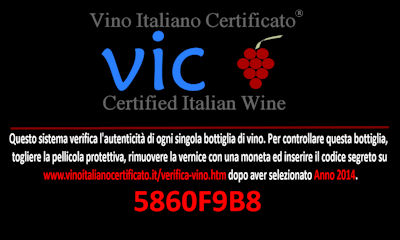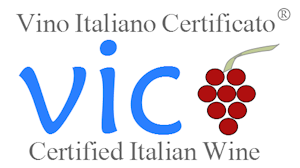Choice of anti-counterfeiting technology
In the study of the anti-counterfeiting system realized for Winecert, we have analyzed the state of art in a precise hystorical moment where the consumer had to represent the heart of the system.
Precisely for this reason we have chosen to use the safest method to realize the anti-counterfeiting system of wine, with the aim of offering consumers the opportunity to check and see for themselves that the whole verification process is really the correct one.

Comparison with others technologies
The use of other technologies, such as electronic chips, or more advanced systems such as NFC or RFID, do not offer this important confrontation with the user, who has to perform a mechanical operation without being conscious of what he is doing.
The insertion of a chip within a cap or a label, does not allow to verify if the system has been breached, or, for example, if you are accessing to a database different from the one for validation.
Everyone knows about the violations of gaming chips, decoder cards, etc., so this technology was immediately eliminated, because it is easily falsifiable!
The same consideration for NFC and RFID, where among other things the consumer is obliged to have a modern smartphone for verifying, but still worth the concept expressed previously, where the user who buys a bottle and must establish its authenticity, he hasn't direct control of what he is doing and especially he doesn't interact with the system, which in this case is totally automated and a simple answer is provided.
Imagine a situation where a counterfeiter creates an APP which is associated a system with NFC or RFID and the user verifies something that really is not an original system and therefore he isn't aware of the scam.
Not to mention that these systems have often had accessibility problems, hacker attacks and invasion of privacy, without considering the possibility of RFID sniffer that could change the content of tags and then invalidate the entire system.
Winecert has a system that allows the consumer to read a hidden code, clear and understandable because, composed by a mixture of numbers and letters, then the consumer personally inserts this code on the indicated website using a smartphone, or a PC, or other device connected to Internet, even on the move.
In doing so the consumer has full control of his actions and moreover verifies in real time that the operation is correct.
Also as repeatedly stated on this website, the generated code is closely linked to the single bottle, using the algorithm invented by Eng. Mirko Tarantelli and above all encrypted on servers.
The choice of technology associated to their own products should not be the result of the current fashion, but weighted according to objective and functional criteria, so it proves the best method of protection for your company, that enhances the brand and makes consumers sharers of conscious action immediately after purchase.
Let's learn more about the RFID technology!
What is RFID and how to use it?
RFID technology, very popular in recent times, has ancient origins, in fact it was used the first time in World War II for aircrafts radar.
Its operation is based on the use of tags, small radio frequency transmitters equipped with a chip and a small memory area on which it is possible to store data and transfer it by means of an incorporated antenna by an electromagnetic field.
In this text we do not want to insert technical features for a specific choice, instead we want that the reader reflects on issues related to the safety and reliability of the system.
Benefits are surely different, but the disadvantages are many, and myself, being an engineer in telecommunications who has studied electromagnetic fields, I am specialized in cyber security and I have outlined some important issues that the use of the anti-counterfeiting RFID system has not!
Problems of RFID used as anti-counterfeiting system
As above-described, first you need to have a mobile device with this technology, but nowadays not everyone have a smartphone with these characteristics.
It must be emphasized that RFID is a technology that uses electromagnetic waves, which generate additional magnetic fields in addition to those already present in nature and in other devices daily used.
Obviously these are fields of not high entity and must comply with the standards required in their respective countries of application.
The electromagnetic waves used in this technology are further exposures to which both the human body and foods are subjected.
The microwave is an example of a domestic appliance widely used in cooking, but harmful to the food, where electromagnetic waves "bombard" food molecules to warm it up, destroying part of nutritional properties.
About information security, possible threats are all those that can cause an acquisition or illicit alteration of information.
The acquisition or the illegal alteration of data contained in tags can take place both through fraudulent question of tags by not authorized readers, either by interception of information, via radio receivers, during a reading of the same by an authorized reader.
This can be achieved by using a long-range reader or by concealing a portable reader near the tags, for example some researchers have recently shown some vulnerabilities to smart cards.
Others security problems are been found in the interception of a third person who initially verifies a proper transmission between tag and reader, rebroadcasting it to another device, phenomenon commonly called Replay.
Another aspect is the clandestine tracking, with the ability to follow the signal emitted by a tag and attach it to its owner.
RFID tags are designed to be read by any compatible device for their reading and may occur at any time and even by considerable distances, without notifying the holder of the tag.
The Denial of Service (DoS) is when you prevent RFID systems to function properly.
In fact, the reading of tags may be hindered by a Faraday cage or by a disturbance in the transmission signal, in both cases the result is given by the waves transmitted by the systems that do not reach the objects having RFID tag.
Obviously also some viruses can be used, such as RFID worms that take advantage of the presence of a network connection; a self-replicating RFID virus is fully self-sufficient, just one infected RFID tag to trigger a viral attack.
The authentication is a problem that has always plagued the RFID, where legitimate readers gather information of illegal tags, thus creating a counterfeit.
In this way a system used as anti-counterfeiting method actually becomes a system for generating counterfeiting.
A way to reduce this risk is to use encryption protocols, but often they are violated.
Conclusions
The correct evaluation of an anti-counterfeiting system that has the task of protecting a product and a company is very important to enhancing not only their own work, but also their customers, who need a simple system verifiable by the consumer, if there are violations.
The choice of Winecert to use a simple and clear system for producers and consumers is the basis for the perfect functionality of an innovative method because closely linked to the product, not crackable in any way.


